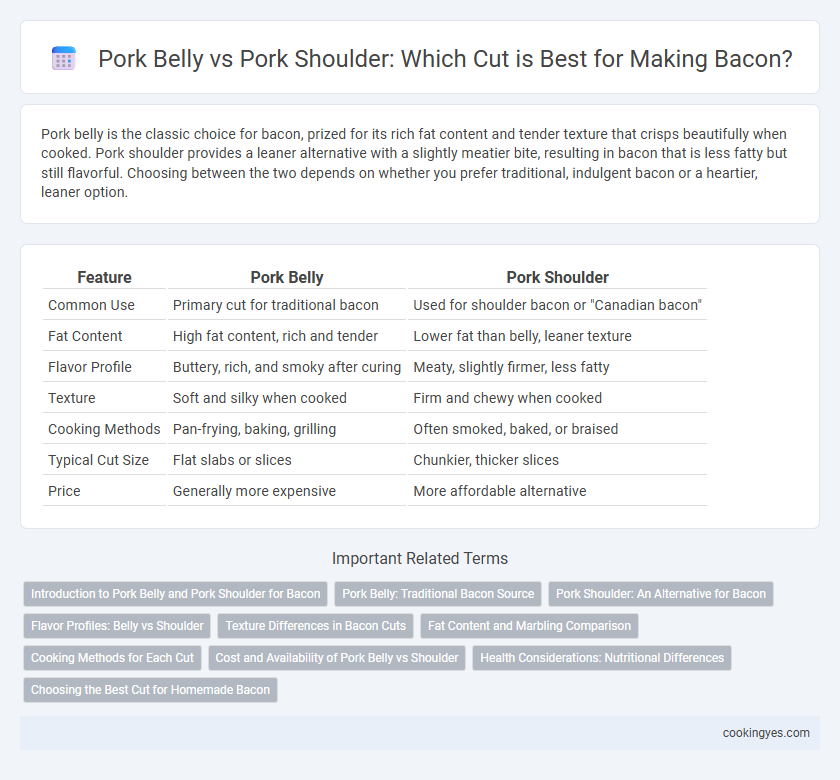Pork belly is the classic choice for bacon, prized for its rich fat content and tender texture that crisps beautifully when cooked. Pork shoulder provides a leaner alternative with a slightly meatier bite, resulting in bacon that is less fatty but still flavorful. Choosing between the two depends on whether you prefer traditional, indulgent bacon or a heartier, leaner option.
Table of Comparison
| Feature | Pork Belly | Pork Shoulder |
|---|---|---|
| Common Use | Primary cut for traditional bacon | Used for shoulder bacon or "Canadian bacon" |
| Fat Content | High fat content, rich and tender | Lower fat than belly, leaner texture |
| Flavor Profile | Buttery, rich, and smoky after curing | Meaty, slightly firmer, less fatty |
| Texture | Soft and silky when cooked | Firm and chewy when cooked |
| Cooking Methods | Pan-frying, baking, grilling | Often smoked, baked, or braised |
| Typical Cut Size | Flat slabs or slices | Chunkier, thicker slices |
| Price | Generally more expensive | More affordable alternative |
Introduction to Pork Belly and Pork Shoulder for Bacon
Pork belly and pork shoulder are two primary cuts used for bacon production, each offering unique characteristics ideal for different bacon styles. Pork belly provides a higher fat content and a richer, tender texture, making it the classic choice for traditional streaky bacon. Pork shoulder, with its leaner meat and more muscle composition, yields a firmer and meatier bacon variant often favored for slab bacon and specialty cured products.
Pork Belly: Traditional Bacon Source
Pork belly remains the traditional and preferred source for bacon due to its ideal fat-to-meat ratio, which provides the characteristic tenderness and rich flavor. Unlike pork shoulder, pork belly offers a consistent texture that crisps perfectly when cooked, making it the quintessential choice for classic bacon production. This cut's high fat content also enhances curing and smoking processes, resulting in the savory, melt-in-the-mouth taste synonymous with premium bacon.
Pork Shoulder: An Alternative for Bacon
Pork shoulder offers a flavorful alternative to traditional pork belly for bacon production, containing more connective tissue that enhances its rich, savory taste after curing and smoking. Its higher fat content compared to leaner cuts provides a tender texture ideal for bacon slices, while the marbling throughout the shoulder contributes to a more complex flavor profile. Choosing pork shoulder allows for versatile bacon preparations, accommodating variations in thickness and seasoning that appeal to different culinary preferences.
Flavor Profiles: Belly vs Shoulder
Pork belly offers a rich, buttery flavor with a higher fat content that renders into crispy, melt-in-your-mouth bacon, while pork shoulder provides a more robust, meaty taste with a firmer texture due to its leaner muscle composition. The marbling in pork belly creates a delicate balance of savory and sweet notes, enhancing traditional bacon's signature flavor. In contrast, pork shoulder's deeper umami profile delivers a heartier, more intense bacon experience favored in artisanal and smoked bacon varieties.
Texture Differences in Bacon Cuts
Pork belly bacon offers a tender, succulent texture with layers of fat and meat that render into a crispy, melt-in-your-mouth experience. Pork shoulder bacon has a coarser, firmer texture due to higher connective tissue, resulting in a chewier bite and a more robust, meaty flavor. The choice between cuts significantly influences the final bacon texture, balancing softness and chewiness depending on preference.
Fat Content and Marbling Comparison
Pork belly is the preferred source for traditional bacon due to its higher fat content and superior marbling, contributing to its rich flavor and tender texture when cured and cooked. Pork shoulder, while leaner and less marbled, contains a more muscular structure with less intramuscular fat, resulting in a firmer texture and a less consistent fat distribution. The fat in pork belly melts evenly during cooking, enhancing the bacon's juiciness, whereas pork shoulder's lean profile makes it less ideal for producing classic, well-marbled bacon slices.
Cooking Methods for Each Cut
Pork belly, known for its high fat content and rich marbling, is best suited for slow curing and smoking methods that render fat evenly, producing tender and flavorful bacon. Pork shoulder, with a leaner texture and more connective tissue, typically requires longer cooking times at lower temperatures or braising to break down fibers before slicing into bacon strips. Choosing the right cooking method enhances the texture and taste unique to each cut's muscle composition and fat distribution.
Cost and Availability of Pork Belly vs Shoulder
Pork belly is the preferred source for traditional bacon due to its higher fat content and tenderness, but it typically comes at a higher cost and can be less readily available compared to pork shoulder. Pork shoulder offers a more affordable alternative with greater availability, though it usually produces a leaner, less fatty bacon. Consumers looking for authentic bacon flavor often opt for pork belly despite the price difference, while budget-conscious cooks may choose pork shoulder for cost-effectiveness and easier sourcing.
Health Considerations: Nutritional Differences
Pork belly is higher in fat content, resulting in richer, more flavorful bacon but increased calories and saturated fat, which may impact heart health if consumed excessively. Pork shoulder contains less fat and more lean protein, offering a slightly lower calorie option with potentially better nutritional balance for those managing cholesterol and calorie intake. Choosing pork shoulder bacon can support a healthier diet while still delivering savory taste, whereas pork belly remains a traditional choice for its texture and flavor richness.
Choosing the Best Cut for Homemade Bacon
Pork belly is the preferred cut for homemade bacon due to its well-balanced ratio of fat to meat, which ensures rich flavor and tender texture after curing and smoking. Pork shoulder contains more connective tissue and leaner meat, resulting in a chewier, less traditional bacon experience. For optimal results, select a pork belly slab approximately 5 pounds with consistent thickness to achieve even curing and smoking.
Pork Belly vs Pork Shoulder for Bacon Source Infographic

 cookingyes.com
cookingyes.com